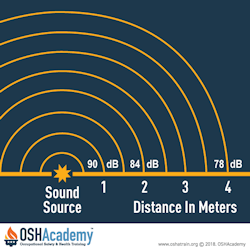Adminstrative Controls
Administrative controls, defined as "management involvement, training of workers, and changes in the work schedule or operations that reduce noise exposure," may also effectively reduce noise exposure for workers.
Examples include:
- Operating noisy machines during shifts when fewer people are exposed.
- Limiting the amount of time a person spends at a noise source. This is probably the most common administrative control being used today in the workplace.
- Providing quiet areas where workers can gain relief from hazardous noise sources (e.g., construct a soundproof room where workers' hearing can recover - depending upon their individual noise level and duration of exposure, and time spent in the quiet area).
- Restricting worker presence to a suitable distance away from noisy equipment.
Controlling noise exposure through distance is often an effective, yet simple and inexpensive administrative control. This control may be applicable when workers are present but are not actually working with a noise source or equipment. In open space, for every doubling of the distance between the source of noise and the worker, the sound level of the noise is decreased by 6 decibels (dB).
Knowledge Check Choose the best answer for the question.
2-4. How much does the sound level decrease when the distance from the source is doubled?
You forgot to answer the question!

